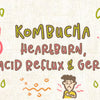Kombucha Troubleshooting Guide: Every Problem, Every Solution
Kombucha is an effervescent drink that’s prepared by fermenting sweet tea. Evidence suggests that it originated from Northern China over 2000 years ago.
The ingredients required to brew kombucha are sugar, water, and tea leaves - black tea being the most common variety. The fermentation process requires a culture of bacteria and yeast. Typically in the form of starter tea from a previous batch and a symbiotic culture of bacteria and yeast (SCOBY). The ferment requires an optimum temperature of 68 to 78º F (room temperature) and typically takes 7 to 14 days to attain that unique flavor.
Kombucha has gained in popularity among health enthusiasts for it’s purported health benefits, which range from restoring a healthy gut bio to increasing immunity.
Why Are There Many Problems When Brewing Kombucha?
Brewing kombucha is a process that relies on a bacteria and yeast culture. These single-celled organisms can be affected by many factors ranging from temperature to light rays. Making it easy to run into many problems. Luckily for every problem, a solution can be crafted by addressing the root cause.
Common Mistakes When Brewing Kombucha
1. Using A Poor Quality SCOBY
Using a weak or old SCOBY results in delayed fermentation and can result in a weak tasting brew. A poor-quality SCOBY contains a reduced amount of bacteria and yeast cells - slowing down the ferment and resulting in a weaker flavor. Poor quality SCOBYs can be identified by the presence of mold growing on them or a darkish hue, they easily break apart too.
Solution: Always buy a higher quality SCOBY, and discard after 6-10 uses.
2. Using Vinegar Instead Of Starter Tea From A Previous Batch
The composition of vinegar lacks any nutritional benefit to the brew. Some sources advise using vinegar as a substitute for starter tea. This is misleading as most fail to mention that concentrated vinegar is different from raw vinegar. While raw vinegar can be used as a last resort, it may negatively impact the brew. Vinegar also lacks the yeast and bacteria culture that’s required to ferment kombucha.
Solution: Only use raw kombucha from a previous brew as a starter tea.
3. Using Artificial Sweeteners Instead Of Cane Sugar
Kombucha requires a natural source of sugar, which the culture feeds on during the fermentation stage. Using artificial sweeteners in place of cane sugar will not work as artificial products lack the carbohydrates required to feed the culture.
Solution: Ensure that you use cane sugar, and if you’re going to use another sugar research the ratios first.
4. Covering The Brew With Airtight Covers
During the first fermentation process, kombucha requires a supply of oxygen. Covering the fermenting drink with an airtight lid is a big no no! This effectively slows down the fermentation process preventing the brew from fully fermenting and gaining the required taste.
Solution: use a thickly woven cotton cloth or coffee filters to cover the brew during the first fermentation.
5. Exposing The Ferment To Harmful Chemicals
Kombucha fermentation requires live cultures, when these are exposed to toxic chemicals such as chlorine; the entire process comes to a halt. Chlorine can sometimes be found in tap water. Other chemicals that might harm your kombucha culture include cleaning detergents and concentrated alcohol.
Solution: only use fresh unchlorinated water to brew the tea. Opt for hot water sanitization instead of using detergents when cleaning your tools and equipment.
6 . Exposure To Harmful Rays
The yeast and bacteria culture involved in the fermentation process are highly susceptible to harmful ultraviolet (UV) rays, which are ever-present in direct sunlight. Exposing your brew to such rays can kill the culture. This will, slow down the fermentation process resulting in a weak tasting brew.
Solution: store the fermenting brew not in direct sunlight.
7. Storing The Fermenting Kombucha In Extreme Temperatures
Kombucha ferments best at an optimum temperature range of 68 to 78º F. Storing the brew in temperature conditions below this can deactivate the enzymes that are responsible for the metabolism process in the culture resulting in a crippling fermentation rate. On the other extreme end, high temperatures will denature the bacteria and yeast cells, effectively stopping any ongoing fermentation.
Solution: Ensure that fermenting kombucha is stored within the optimum temperature range. You can use a kombucha heating mat during the winter to keep the brew warm during the cold weather. Always keep an ambient temperature thermometer near the brew to monitor the temperature on a daily basis.
For more information about Heating Mats, considerations before buying and all things to consider check out our article here: Kombucha Heating Mats.
Troubleshooting Kombucha's Taste

Raw kombucha has a slightly sweet taste with tart and vinegar-like flavors. The slight sweetness is the remaining sugar after fermentation, and the vinegary taste from the acetic acid that’s produced during the ferment.
1. My Kombucha Tastes Too Vinegary, What Should I Do?
Vinegary kombucha is a result of the accumulation of acetic acid; this can be fixed by flavoring the brew in a second ferment. A second fermentation with a sweet-tasting flavor such as fruits usually fixes this problem as the fruity flavors get infused to the brew making it less vinegary and more refreshing.
[Warning Science!] When the yeast culture breakdown the sugar molecules in the tea they usually release ethanol. The ethanol gets broken down into acetic acid by the bacteria culture. When the fermentation process is allowed to go on for too long the acetic acid produced accumulates, making the kombucha too vinegary.
2. My Kombucha Is Too Sweet, What Should I Do?
Usually, too sweet kombucha is an indication of incomplete fermentation. For a steady, sweet/sour balance, ensure the temperatures are optimal and that the SCOBY microbe is balanced. You can also use more starter, and less sugar. Increase the tea strength and finally ensure the brewing is within the required temperature range (68- 78 °F). Alternatively, you can extend the fermentation time by a couple of days while checking in on the flavor changes on a daily basis until the brew attains your desired taste.
3. My Kombucha Is Too Sour, What Should I do?
Kombucha becomes too sour when the culture feeds on all of the sugar in the brew; this can be remedied by taking it through a second ferment. During the second ferment, a secondary flavoring ingredient preferably one that’s sweet, can be added. This introduces additional sugar into the brew making it less sour. The extra sugar will also get broken down by the yeast and bacteria cells over time which releases more carbon dioxide into the brew making it fizzy.
4. My Kombucha Is Too Tart, What Should I Do?
When left to ferment for too long, the acetic acid concentration in kombucha can increase making it too tart. This can be fixed by flavoring the raw kombucha with a sugar-rich ingredient such as fruits and berries in a second ferment setup. The flavored kombucha can then be moved to the fridge after 3 days, where the lower temperature will prevent further fermentation and in turn, reduce acetic acid accumulation in the drink.
5. My Kombucha Tastes Very Weak What Should I Do?
When kombucha isn’t allowed to ferment fully for 7 to 14 days, it gains a weak taste. This can be fixed by merely allowing the brew to ferment fully for up to 14 days. If the brew fails to obtain the required flavor then the chances are that it is lacking the crucial yeast and bacteria culture required to get the fermentation process going. In this case, you can add an extra SCOBY to the brew as well as extra starter tea from a previous brew and allow it to ferment for another week.
6. Why Does My Kombucha Taste Like Alcohol?
As the yeast culture breaks down the dissolved sugar, substantial amounts of ethanol get produced, which gives the brew an alcoholic taste. The amount of ethanol in the brew accumulates and can even go up to 5% - as it is the case in hard kombucha.
To reduce the alcoholic taste in kombucha, you will have to reduce the yeast culture activity while increasing the bacteria culture activity so that most of the alcohol gets broken down. This can be done by lowering the brew’s temperature to below 74º F. this will reduce the metabolism rate of the yeast cells but the bacteria culture will still operate normally as its more adapted to lower temperatures while yeast is adapted to high temperatures.
Troubleshooting Kombucha Smells
Raw kombucha has a slightly yeasty smell with with notes of vinegar. This is due to the yeast culture and acetic acid produced by the bacteria culture. The type of tea used will also leave behind hints of its scent too.
1. My Kombucha Smells Too Yeasty
Kombucha will smell too yeasty if the culture is no longer at a symbiotic balance, and the yeast population has grown exponentially. This is mostly as a result of either brewing at above-average temperatures or using too much sugar.
To reduce the yeasty smell in kombucha, simply lower the temperature of the brew to below 74ºF (68-70 should be perfect). This will reduce the growth of yeast cells. Alternatively, you can filter the brew with a coffee filter and take it through a second ferment.
2. My Kombucha Smells Too Eggy
Kombucha can develop an unpleasant eggy smell due to the accumulation of sulfur in the drink. This can be caused by contamination of the brew by wild airborne yeasts which produce sulfide gases. While this doesn’t cause any health concern, it can be quite unsettling.
Unfortunately, there’s no way of fixing such a brew and its recommended not to use the infected SCOBY on any other brew and it should be disposed of after the ferment is done. You can drink the kombucha but if the smell is too unpleasant just dump it down the drain together with the affected kombucha.
Troubleshooting Your Kombucha SCOBY

A healthy SCOBY ranges in size and appearance depending on its age. A baby SCOBY is almost translucent when it first appears on a brew, as it thickens it develops a creamy white color. As it ages, it will turn yellowish and finally greyish with the final stage having almost black color; by then, it will be time to throw it away.
The surface of the SCOBY is smooth without any blemishes other than the thin brownish strands of yeast that might be growing on the surface.
1. My SCOBY Is Fuzzy And Moldy, What Should I Do?
If you notice mold growing on your SCOBY and it’s becoming fuzzy, then that’s an indication that the bacteria and yeast culture are no longer in control. Such infected SCOBY should be disposed of immediately together with any brew that it might have been fermenting at the time. This is because a healthy SCOBY has antibacterial and antifungal properties which prevent fungi and mold from growing on it.
2. My SCOBY Has White Yeast Coverage, What Should I Do?
The presence of a cloud of white yeast covering the SCOBY indicates that a baby SCOBY is about to grow from the older one. After a while, a thin transparent biofilm forms from the white yeast and bubbles surrounding it. The baby SCOBY can be used to start another brew and will grow in size with each successive brew to finally become a SCOBY mother as well.
3. My SCOBY Sank Is It Still Alive?
Yes, a SCOBY will often move around in the course of the fermentation period and its natural for it to sink. These movements are driven by changes in its density and temperature difference between the SCOBY and the brew. As the brew progresses, the SCOBY will float back near the surface where there’s more oxygen.
4. My SCOBY Turned Black, Is It Still Alive?
As the SCOBY grows old, it tends to discolor and turn greyish and finally black meaning its no longer alive. Dispose of old SCOBYs. SCOBYs which have become black are also more susceptible to mold growth which might contaminate the entire brew.
5. My Dehydrated SCOBY Is Not Doing Anything
A dehydrated SCOBY requires up to 4 weeks of activation process before it can be used to start a ferment. You will require distilled white vinegar and freshly brewed and sweetened tea to activate the SCOBY. After the SCOBY has been activated, it can then be used to start a brew; note that the first brew will take much longer to fully ferment as the SCOBY needs to regrow its yeast and bacteria culture population. If you are having no positive results by the third week, then its time to throw away the dehydrated SCOBY.
6. Why Didn’t My SCOBY Make A Baby?
A SCOBY can fail to make a baby if the brew doesn’t have enough nutrients in it or if the SCOBY is still small in size, and it has been used to ferment a significantly large amount of kombucha. A baby SCOBY can also fail to grow if the mother SCOBY is too old or if the brew has been fermented for a relatively short period of time.
Troubleshooting Raw Kombucha
1. Why Is My Kombucha Not Fizzy?
Kombucha can fail to become fizzy if less carbon dioxide has been produced or if it been shaken too much and the gas allowed to escape. This can be solved by taking the drink through a second ferment in which a flavoring ingredient is added and a bit of white sugar gets added. The drink is then airtight sealed and set to ferment for 3 to 5 days, during which the carbon dioxide produced gets trapped within the brew making it fizzy.
More information about second ferments can be found here: Kombucha Second Fermentation Guide.
2. Fruit Flies Have Invaded My Kombucha, What Should I Do?
Fruit flies are often attracted to sweetly flavored brews, and if the fermentation jar isn’t well covered with a thickly woven breathable cloth, they will contaminate the kombucha.
If you notice that fruit flies have invaded an ongoing ferment, then the chances are that they have already laid eggs in the brews which will hatch in a few days, infesting the entire setup with fruit fly larvae.
In such a case, it's recommended to toss away the contents of the jar and wash it thoroughly before using it on another project.
3. Why Is My Kombucha Brewing So Slowly?
Kombucha brews slowly if it's exposed to extreme temperature conditions or if the setup does not contain the right ratio of ingredients. Check the ingredients and temperature of the batch to troubleshoot the issue.
Troubleshooting Kombucha pH

pH is used to measure the acidity of a substance and relies on a scale ranging from 0 to 14, whereby 0 is the most acidic and 14 is the most alkaline. Raw kombucha has a pH range of between 2.5 and 3.5. You can use a pH strip to test the acidity of kombucha as it indicates how well the brew is performing. A low pH means that the drink is almost fully fermented as the accumulation of acetic acid drives the pH down to nearly 2.5. On the other extreme, a pH of 4.5 indicates that the brew is not fermenting as fast as it should; if it rises beyond this, then the brew is considered to have spoiled and should be discarded.
What To Do If You pH Is Too Low?
When the pH of kombucha drops to below 2.5, it becomes too acidic to drink. This can be changed by either diluting the drink with water before drinking it or simply taking it through a second ferment with considerable amounts of flavoring such as fruits. Be sure to check the pH again before drinking!
Decreasing the fermentation time will also ensure that the Kombucha does not get too acidic. Using less starter tea and reducing the fermentation temperatures also slows the fermentation process hence the acetic acid production.
What To Do If Your pH Is Too High?
If the kombucha is too basic, you can extend the fermentation period to allow further accumulation of acetic acid which would eventually lower the ph. Alternatively, you can add extra sugar to boost the production of ethanol which in turn results in more acetic acid production by the bacteria culture.
For more information about pH and kombucha, we have a full guide which details all things pH, how to influence and it's important role during fermentation. Check it out here: Kombucha & pH The Brewer's Guide
How To Reduce The Sugar Content
Increasing The Fermentation Time
Fermenting the kombucha for an extended period allows the yeast culture to break down most of the sugar in the drink making it less sugary.
How To Reduce The Alcohol Content
The alcohol content in kombucha can be reduced by lowering the fermentation temperature which significantly minimizes the ethanol production by the yeast culture, allowing the bacteria culture to break down most of the ethanol into acetic acid.
How To Reduce The Caffeine Content
Caffeine can be decreased in kombucha by allowing the brew to ferment for an extended period of time so that the culture can feed on most of the caffeine. However, the best way to ensure that you end up with caffeine-free kombucha is by using decaffeinated tea leaves or a caffeine-free alternative such as rooibos tea.








My kombucha looks like beer (tan foam floating on amber liquid, no pellicle) and is fizzy despite it being a first ferment. Tastes OK, but I think it’s stalled.
I just took opened the gallon jar and instead of a baby scoby there was an almost transparent skin sealing the top of the jar with the beginning of a scoby attached. it was sealing the jar! The only difference I can think of in my method with this batch is that I used a heavier cotton cloth to cover the jar. Could lack of oxigen have caused this? Is the kombucha safe to use both to drink and to start my next batch?
Hi, recently I have noticed that my kombucha gives me very bad gas. Why is this and what can I do to fix it?
Hi, my Kombucha scoby stopped fermenting my tea after it was exposed to sauerkraut ferment. How can I fix this? I started a new batch and all I get is a white powdery surface. Help!!